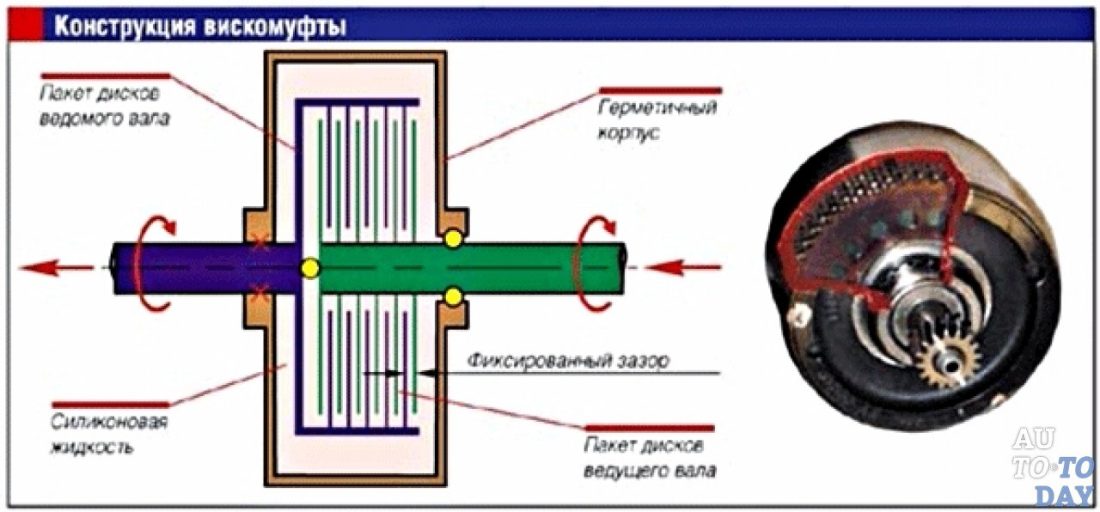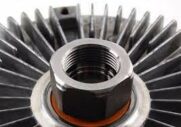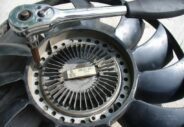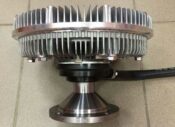
Fan viscous coupling working principle
Content
The viscous fan coupling is one of the lesser known components of the engine cooling system.
What is a viscous fan coupling
Viscous fan clutches are used on cars (cars and trucks) with a longitudinally mounted engine, mainly rear-wheel drive cars. The clutch is required at low speeds and at idle to control temperature. A defective fan can cause the engine to overheat during idle or heavy traffic.

Where is
The viscous fan clutch is located between the pump pulley and the radiator and performs the following functions:
- Controls the fan speed for cooling the engine;
- Helps in engine efficiency by turning on the fan when needed;
- Reduces the load on the engine.
Fastening the coupling
Either the coupling is mounted on a flanged shaft mounted on the pump pulley, or alternatively it can be screwed directly onto the pump shaft.
The principle of operation of the viscous coupling
The viscous coupling is based on a bimetallic sensor located at the front of the viscose fan. This sensor expands or contracts, depending on the temperature transmitted through the radiator. This smart component improves engine efficiency by regulating the engine fan speed and supplying cold air.

Cold temperatures
The bimetallic sensor compresses the valve so that oil inside the coupling remains in the reservoir chamber. At this point, the viscose fan clutch is disengaged and rotated at about 20% of the engine speed.
At operating temperatures
The bimetal sensor expands, rotating the valve and allowing oil to travel throughout the chamber to the outer edges. This creates sufficient torque to drive the cooling fan blades at engine operating speeds. At this point, the viscous fan clutch engages and rotates about 80% of the engine speed.
What can a faulty viscous coupling lead to?
When replacing the pump, it is always recommended to check the condition of the viscous fan clutch. A damaged coupling will directly affect pump life. A faulty viscous fan clutch can remain stuck in the engaged position, which means it will always run at 80% of engine speed. This can lead to breakdown with high levels of noise and vibration, creating a loud vortex sound as the engine rpm increases and fuel consumption increases.
On the other hand, if the viscous fan connection fails in the off position, it will not allow air to pass through the radiator. This, in turn, will lead to overheating of the engine when the cooling process stops.
Causes of breakage
- Oil leakage from the clutch, disconnection of the fan clutch;
- The bimetallic sensor loses its properties due to surface oxidation, causing the sleeve to get stuck;
- Bearing malfunction, although it can rarely occur if the viscous fan clutch has not been replaced after a long mileage. This leads to a deterioration in the condition of the surfaces.
Viscous coupling sensor operation

A bimetallic sensor controls the operation of the viscose clutch. Primarily, there are two types of bimetallic sensing systems: plate and coil. They both work on the same principle as explained earlier.
The only difference is that as the coil expands and contracts to rotate the rotation plate, the bimetal contracts and flexes. This moves the slide plate and allows the oil to move from the reservoir chamber into the cavity.
Video: how to check the viscous coupling
Questions and answers:
How does the fan drive viscous coupling work? Its rotor is connected to the crankshaft pulley using a belt drive. A disc with an impeller is connected to the rotor through the working fluid. When the fluid heats up, it thickens and torque begins to flow to the driven disc.
How to understand that the viscous coupling is faulty? The only sign of a faulty viscous coupling is overheating of the motor, and the fan does not spin. In this case, the gel may leak out, the coupling may jam (extraneous sounds are heard).
What is the viscous coupling for? The viscous clutch is designed to temporarily connect one set of discs to a master set. The viscous coupling of the cooling fan provides cooling of the radiator. A similar mechanism is also used in four-wheel drive cars.
ЧWhat is a fan clutch? Depending on the temperature of the coolant in the engine, it changes the fan speed. When it heats up, the clutch increases the fan speed.